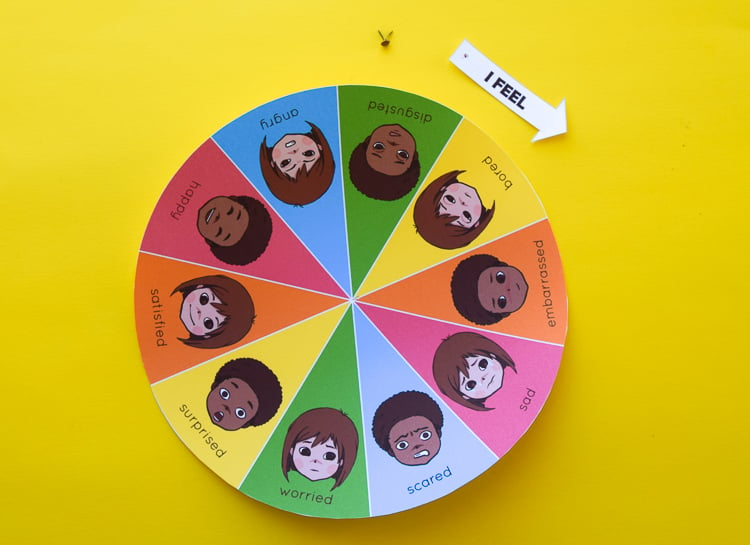

In the green section of happy are the feelings: optimistic, intimate, peaceful, courageous, satisfied, proud, curious, and joy. In the blue section of sad are the feelings: shame, apathetic, despair, depressed, lonely, and guilt. In the purple section of disgust are the feelings: disapproval, disappointed, awful, and aversion. In the red section of anger are the feelings: offended, insecure, hateful, mad, aggressive, irritated, distant, and critical. The third circle is where the corresponding feelings to those emotion categories are written. Moving clockwise from the top right, the categories read: anger (red), disgust (purple), sad (blue), happy (green), surprise (yellow), and fear (orange). The inner circle is solid grey with a white title that reads “Emotion Sensation Wheel.” The second circle – moving outward – is where major emotion categories are written. The Emotion Behavior Wheel consists of four layers of rings and six sections of colors: red, purple, blue, green, yellow, and orange. Even though everyone’s body cues are just a little bit different, researchers in Finland found that for most of us, the felt sensation of any specific emotion is pretty similar from individual to individual. For example, a particular twisting of our gut is the nuanced version of anger we call irritation or a certain sort of heaviness in the chest is sadness. With this catalog, humans can – in a split second and without conscious thought – understand specific embodied, emotional experiences. Over time and through countless interactions that increase in complexity, children internalize an entire catalog of emotions and their corresponding body-sensations. Or, they saw our wide-eyed panic at the appearance of a new person as they named and soothed our “fear.” Way back, an attuned caregiver noticed our eyes welling up with tears and affirmed our “sadness” as they comforted us. When we can easily name an emotion we’re feeling, it’s because we’ve had a lifetime of practicing. Many emotional experiences, researchers at Columbia University have shown, start in the body before moving into awareness. Good use of this resource should expect and embrace responses like, “That’s definitely not true for me” or “Actually, that belongs over in that section.” All responses generate opportunities for making connections, help integrate mind and body, and prompt valuable conversations that can help people grow in understanding how their unique body-sensations and emotions are connected. This chart is not intended as an assessment tool or scientific measure. A fill-in-the-blank worksheet for growing self-awareness.My emotion sensation wheel prompts mind-body awareness, connection, and conversation.

When people have not had practice recognizing and labeling their emotions, asking them to identify complex emotions becomes an intellectual exercise with limited opportunity to promote growth and change. Become a patron & get instant access to this RESOURCE + my entire portfolio WHY?


 0 kommentar(er)
0 kommentar(er)
